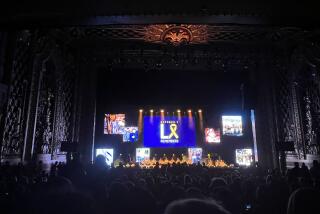Ceremonies Recall Armenian Genocide
- Share via
With poetry and protests, Armenian Americans gathered from Glendale to Irvine on Monday to commemorate the 85th anniversary of the genocide of 1.5 million Armenians at the hands of Ottoman Turks.
Southern California is home to an estimated 500,000 Armenian Americans, the largest Armenian community outside the Republic of Armenia.
The largest gathering Monday took place at Bicknell Park in Montebello, where speakers urged the more than 4,000 people assembled to remember the tragic events of April 24, 1915--the date recognized as the start of the systematic killing of Armenians living in the Ottoman Empire over the following seven years.
The current Turkish government still denies that Turks were responsible for the mass executions, forced death marches and starvation of the Armenians.
During the Montebello ceremony, Armenian leaders, including Raffi K. Hovannisian, the former foreign minister of Armenia, laid a wreath at the Armenian Martyrs Memorial Monument.
Throughout the demonstrations Monday, college students wore black T-shirts bearing such slogans as “Never Again” and “Turkey Is Guilty of Genocide.”
“I came here to show respect for the people who died in the genocide,” said Armen Morad, a Cal State Northridge student who attended the ceremony at Bicknell Park.
He said events like Monday’s are important because most public schools don’t teach about the Armenian genocide.
“That is the sad part,” he said. “It is not discussed in history classes, only in private Armenian schools.”
But on Monday at least, the topic was discussed at Glendale High School, where more than 1,800 students gathered to take in Armenian music and dance presentations. About half of the school’s 3,385 students are of Armenian heritage, and most left classes to attend commemorative events outside the school.
“The school is going to be crippled today,” said Glendale High School Armenian club advisor Vahe Bozoian.
“We wish we could celebrate April 24 as an official holiday instead of skipping school.”
Earlier in the day, those students and others protested in front of the Turkish Consulate in Los Angeles’ Wilshire district, waving signs that said “Turkey Must Pay.” To guard against the possibility of violence, all parking was barred within a block of the consulate.
Aykut Berk, the consul general of Turkey, called the demonstrations an act of misinformation. He said Armenians were relocated during World War I because “armed Armenian thugs” living in the Ottoman Empire had turned against the Turks to support the country’s invading enemies.
“These are the people who stabbed us in the back,” he said.
He conceded that many Armenians died during the war but said that they were the victims of “a war of survival,” not a systematic effort to wipe out a group of people based on their ethnicity.
“It was a very tragic event, but this has two sides to the story,” Berk said.
The events--recognized by many historians as the 20th century’s first genocide--unfolded as a nationalist group called the Young Turks took control of what remained of the multicultural Ottoman Empire, which had recently lost Bulgaria, Libya, Crete and the Balkans.
At many of the gatherings Monday, Armenian Americans blasted the Turkish government for failing to take responsibility for the deaths.
“Some may pretend, but everyone knows it happened; it’s impossible not to when 1.5 million people died,” said Sarkis Yegenian, 68, the Jordan-born trustees chairman of the Forty Martyrs Armenian Apostolic Church in Santa Ana.
Yegenian was born almost 20 years after the genocide, but said his parents and grandparents described losing brothers, sisters, children and other relatives to violence or starvation. “They would cry when they talked about it,” said Yegenian.
Outside the UC Irvine administration building Monday night, more than 100 people remembered the genocide with speeches, interpretive dances, poetry and a candlelight vigil.
“This is part of an arduous process to get recognition that this great tragedy happened,” said Vahe Ghookassian, 22, president of the Armenian Student Assn.
In downtown Los Angeles, dozens of local, state and federal elected officials and law enforcement leaders gathered at the Kenneth Hahn Hall of Administration to hear Richard Sezibera, Rwanda’s ambassador to the United States, compare the Armenian genocide to the Rwandan genocide of nearly 1 million Tutsis in 1994. “We are witnesses to the eternal truth that the victims of genocide will and must triumph in the arena of public discourse if humanity is to escape the pitfalls of yesteryear,” he said.
Organizers of the various commemorative events said the struggle to recognize the genocide is more difficult each year because fewer survivors are alive to tell of the atrocities.
Ara Marifyan, 67, of Glendale, said his grandparents were killed in the genocide, but his parents escaped to Syria before he was born. He said he attended the ceremony in Montebello to keep their memories and the memories of other victims alive.
“More and more people are spreading the word,” he said. “They know what happened.”
*
Times staff writers Hector Becerra and Edgar Sandoval contributed to this story.
More to Read
Sign up for Essential California
The most important California stories and recommendations in your inbox every morning.
You may occasionally receive promotional content from the Los Angeles Times.














